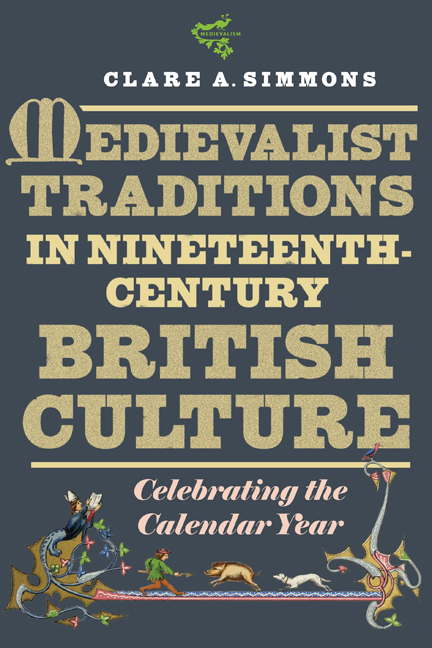Book contents
- Frontmatter
- Dedication
- Contents
- List of Illustrations
- Preface
- Acknowledgments
- List of Abbreviations
- Introduction: Medievalizing Time
- 1 The Christian and Not-So-Christian Year
- 2 Medievalist Calendar Experiments
- 3 Christmas Becomes a Season
- 4 Winter Love: St Agnes and St Valentine
- 5 Rites of Spring: Imagining Origins
- 6 Summer Festivals: Religion in Performance
- 7 Fragmented Autumn: Harvest-Home to Lord Mayor's Show
- Epilogue: Christmas Ghosts
- Bibliography
- Index
- Miscellaneous Endmatter
Introduction: Medievalizing Time
Published online by Cambridge University Press: 09 February 2021
- Frontmatter
- Dedication
- Contents
- List of Illustrations
- Preface
- Acknowledgments
- List of Abbreviations
- Introduction: Medievalizing Time
- 1 The Christian and Not-So-Christian Year
- 2 Medievalist Calendar Experiments
- 3 Christmas Becomes a Season
- 4 Winter Love: St Agnes and St Valentine
- 5 Rites of Spring: Imagining Origins
- 6 Summer Festivals: Religion in Performance
- 7 Fragmented Autumn: Harvest-Home to Lord Mayor's Show
- Epilogue: Christmas Ghosts
- Bibliography
- Index
- Miscellaneous Endmatter
Summary
IN SIR WALTER Scott's 1816 novel The Antiquary, published somewhat ominously at the beginning of what should have been summer in the notorious Year Without a Summer, Jonathan Oldbuck, the Antiquary of the title, asks for an “almanack.” From this he determines that his friends Sir Arthur Wardour and his daughter Isabel are in deadly danger from the oncoming high tide.
By the 1790s, when this story is set, “almanacks” had become a significant part of local infrastructure. The Edinburgh Almanack and Scots Register for 1794, for example, contains lists of important Scots officials, useful information such as postage rates and mail coach times, and what is proudly described as “a Correct Kalendar.” The Kalendar includes saints’ and festival days; the phases of the moon; what times the sun and moon rise and set; and high and low tides at the nearby port of Leith. It thus combines ancient knowledge as preserved in the church ritual calendar with scientific observation and local use of time.
The Antiquary himself is acutely aware of time. Fascinated by anything ancient, he has invited his friends to enjoy an authentically antiquarian meal of “Solan Goose” (gannet) with his new friend Lovel. The invitation is for 4pm on “Tuesday the 17 current stilo novo” (36). The reference to the “new style” calendar (Britain had adopted the Gregorian calendar in 1752) seems remarkably precise. In point of fact, since the story started on Tuesday July 15 and several days seem to have elapsed, the precision is fictional rather than historical. If as David Hewitt has argued, the story takes place in 1794 (357), resources such as the Edinburgh Almanack reveal that that July 17 was not a Tuesday, and that the tide would not have been especially high any evening around that time. Nevertheless, within the fictional time of the novel, the Antiquary combines historical, local, and documented knowledge of time.
The Antiquary is, of course, a historical novel, even if the historical distancing is brief. Completed after the Battle of Waterloo, when the outcome of the wars with France was certain, the story turns back time a few years to a point when invasion seemed a possibility, and when an elderly man like Jonathan Oldbuck would have been able to recall the struggles between the houses of Stuart and Hanover: Jacobites and Jacobins are both real threats to him.
- Type
- Chapter
- Information
- Medievalist Traditions in Nineteenth-Century British CultureCelebrating the Calendar Year, pp. 1 - 14Publisher: Boydell & BrewerPrint publication year: 2021

